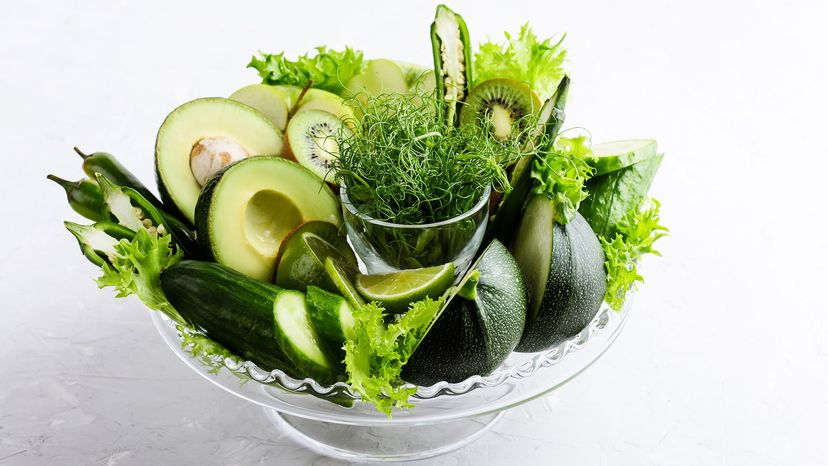 “A bowl with fruits and vegetables surrounds some microgreens. Many people say microgreens have a better flavor and are more nutritious than regular-sized veggies. istetiana/Getty Images
“A bowl with fruits and vegetables surrounds some microgreens. Many people say microgreens have a better flavor and are more nutritious than regular-sized veggies. istetiana/Getty Images
Sometimes big things come in small packages, and this is oh-so-true for microgreens, the petite roughage that has recently taken the foodie world by storm. While for years you’ve probably spied microgreens atop a dish as a garnish, their vibrant flavor and purported health benefits have since helped them to break out into the larger nutrition scene, and they’re showing up in farmer’s markets and conventional grocery stores all over. But do they really live up to their hype?
What They Are
Microgreens are younger versions of many veggies you already know and love, they’re just harvested way sooner (typically when they’re between 1 and 3 inches or 2.5–7.5 centimeters tall, around five to 12 days after planting). They are larger than sprouts, but smaller than the baby versions of leaf veggies (like baby spinach, which is just a smaller version of a mature spinach plant).
Typically, microgreens are grown from seeds within certain families, like the Brassicaceae family, which includes members like broccoli, cabbage, arugula, radish and cauliflower. Other microgreen varieties across different families use seeds from veggies such as lettuce, radicchio, carrots, dill, celery, onion, leek, quinoa swiss chard, beets, spinach, squash and cucumber, among others.
Despite their wee size, microgreens are nonetheless in possession of surprising flavor. "Most of them are tastier than their ‘older’ cousins," says Serdar Mizrakci, a greens expert and founder of Element Farms in an email. "They often have a stronger flavor of whatever the green is. So radish microgreens will be more radishy, the flavor of beet microgreens will be more pronounced, and pea shoots will taste like the freshest peas you’ve ever eaten."
They’ve also exploded in popularity. "I’ve seen a 100 percent increase in demand for micro greens. Three years ago, when we started doing pea shoots, they weren’t easy to sell," says Jon Graziano, assistant farm manager at Holly Hill Farm, an organic non-profit farm in Cohasset, Massachusetts via email. "I had to do a lot to make the market … selling larger quantities for lower prices, doing a lot of sampling, trying to explain to people why they were good for them. Now they want them."
But Are They Better for Us than Bigger Greens?
By all accounts, microgreens appear to be rich in nutrients such as zinc, iron and potassium, as well as disease-fighting antioxidants. "With high levels of sulforaphane and B vitamins, they work to support methylation, your body’s biochemical superhighway that controls your ability to detox," says functional medicine expert and author Dr. Will Cole in an email.
"Microgreens are younger than the greens we’re used to eating in salad," Mizrakci explains. "That means they haven’t yet expended all of their energy and nutrients (phytonutrients) to grow. So we get them instead." Indeed, at least one study on 25 microgreens (like red cabbage and cilantro) found that microgreen leaves had higher concentrations of nutrients, like vitamins and minerals, than their older counterparts. "These higher concentrations of vitamins and minerals could mean more nutrition per bite," says Amanda Kostro Miller, R.D., L.D.N., who serves on the advisory board for the safety websiteFamily Living Today via email.
However, microgreens have not been proven definitively healthier than their larger cousins. "While there has been some research comparing the nutritional content of microgreens vs. mature greens, more research is needed to determine microgreen-specific benefits that would make these vegetables stand out from other healthy vegetables," says Miller.
A study onamaranth microgreens found the nutritional level was about the same for microgreens and fully grown amaranth. So the benefits may depend on which vegetable is used, as well as the type of soil it’s grown in and when it is harvested.
How to Eat Microgreens
To get the most nutrition out of your microgreens, dietician Miller suggests purchasing the whole plant, roots and all. "Doing so can keep the microgreens fresh and potent upon consumption. Microgreens are relatively easy to grow in a pot on your kitchen counter," she notes. (See our sidebar).
Once you have them in the kitchen, Asheville, North Carolina-based chef Joe Scully who co-owns the restaurants Chestnut and Corner Kitchen, advises home chefs to never cook them. "Microgreens are best used fresh, so you get the optimal level of nutrients and enzymes," he says. He suggests adding a handful in with salads, or using them to garnish vegetarian entrees, side dishes or soups. Blending microgreens in with smoothies is another sneaky way to reap their benefits in a non-overwhelming fashion.
If you’re looking to expand your microgreen menu a bit, Chef Nick Cobarruvias of Son’s Addition, a restaurant located in San Francisco’s Mission district, has some easy tips. "One way we use them at the restaurant that is very approachable for the home cook is to add them on top of tostadas, tacos, and tamales. We like to throw together toasted chiles with microgreens and add a squeeze of lime for a perfect topper," he advises. But really, the sky is the limit when it comes to use, he says. "Microgreens add great color, texture, and delicate flavors to any dish."
Now That’s Cool
Interested in setting up your own micro-farm? It’s easy enough with a microgreen grow kit (purchased online or in a home and garden store), as well as a few tips from the experts via an online instructional video or two.


